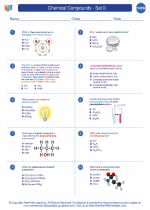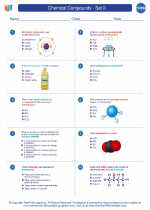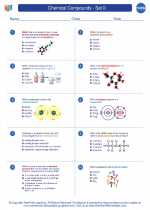Atom
An atom is the smallest unit of matter that retains the properties of an element. It consists of a nucleus, which contains protons and neutrons, and electrons that orbit the nucleus in specific energy levels.
Structure of an Atom
The nucleus of an atom contains positively charged protons and neutral neutrons. The number of protons determines the element's identity and is referred to as the atomic number. The total number of protons and neutrons in the nucleus is called the mass number.
The electrons, which carry a negative charge, orbit the nucleus in specific energy levels or shells. These energy levels are labeled with the principal quantum number (n), with the first energy level closest to the nucleus having the lowest energy and subsequent levels having higher energies.
Atomic Number and Mass Number
The atomic number (Z) of an element is the number of protons in the nucleus. It is unique to each element and determines its position on the periodic table.
The mass number (A) of an atom is the total number of protons and neutrons in the nucleus. It can be used to calculate the number of neutrons by subtracting the atomic number from the mass number (A - Z = number of neutrons).
Isotopes
Isotopes are atoms of the same element that have the same number of protons but different numbers of neutrons. This results in variations in their mass numbers. Isotopes of an element have similar chemical properties but different physical properties due to their differing atomic masses.
Electron Configuration
Electron configuration refers to the arrangement of electrons in an atom's energy levels. Electrons occupy the lowest energy levels available before filling higher ones, following specific rules and principles, such as the Pauli exclusion principle and Hund's rule.
Study Guide
To study the topic of atoms, it is important to understand the following key concepts:
- The structure of an atom, including the composition of the nucleus and the arrangement of electrons in energy levels.
- The relationship between atomic number, mass number, and the number of protons, neutrons, and electrons in an atom.
- The concept of isotopes and their impact on the properties of elements.
- The principles governing electron configuration and the rules for filling energy levels with electrons.
- Practice problems involving atomic number, mass number, isotopes, and electron configurations to reinforce understanding.
Additionally, visual aids such as diagrams of atomic structure and periodic tables can aid in understanding the organization of elements based on their atomic numbers and electron configurations.
Understanding the atom is fundamental to comprehending the behavior of matter and the interactions of elements in chemical reactions. It serves as the foundation for further studies in chemistry and related fields.
[Atom] Related Worksheets and Study Guides:
.◂Chemistry Worksheets and Study Guides High School. Chemical Compounds - Set II

 Worksheet/Answer key
Worksheet/Answer key
 Worksheet/Answer key
Worksheet/Answer key
